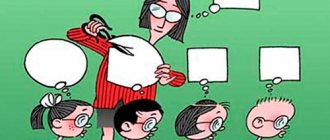Updated July 20, 2022 409 Author: Dmitry Petrov
Hello, dear readers of the KtoNaNovenkogo.ru blog. We can perceive objects: their color, shape, size. Build a logical chain between them. Imagine in your head with your eyes closed. And also think about absolutely abstract things and make plans for the future.
All this is provided by our thinking. It is limitless in its functions and manifestations. To date, all processes have not been fully studied. But we will still tell you something interesting here.
Thinking is...
Thinking is a cognitive process through which the reality around us is reflected, a way of interacting with the outside world. Often thinking is associated with a task and problem that needs to be solved.
It has two important features:
- This is mediation . A person first perceives information through the senses. Through these sensations the idea of objects is formed. You reach some properties through others, and based on facts you can think about broader things.
- The second is generality , which is related to the first feature. All properties of objects are combined with each other. And a person connects them while thinking like a puzzle, and thus the overall picture of the world appears.
As they said earlier, thinking actively works when resolving a situation. The process of gradual development of thinking can be described in 4 stages:
- Awareness of the presence of a problem after analyzing information over a period of time.
- Formation of hypotheses and search for solutions.
- Testing hypotheses.
- Solving a problem situation.
Structure of activity and its motivation (grade 10)
Activity as a process has a specific structure:
Activity structure | The subject is the one who acts, from whom activity comes. |
| The object is what the action is directed towards. | |
| Motive is a conscious impulse/need that justifies an activity. | |
| Goal is an idea of the ideal result of an activity. | |
| Means are objects and methods of action that are used in the course of activity. | |
| Action is a component of activity, relatively autonomous, with a specific task. (All activity as a whole consists of individual actions: actions, deeds, and so on). | |
| Result is the final result of an activity, a state in which a need is satisfied (may differ from the goal of the activity). |
Thought processes
To solve a problem and reveal the essence of a phenomenon/situation, thought processes are activated. Depending on the purpose, one or another type of information processing will be used.
Analysis and synthesis
Synthesis is the combination of details, properties and actions into a holistic picture, depending on the relationships between these parts.
Analysis is the reverse process of synthesis, which consists of decomposing the whole into smaller bricks.
People can do this practically by connecting their thinking. For example, in kindergarten, at work. A clear and simple example would be the same constructor or the construction of a house.
This can also happen exclusively logically in the head, analyzing the general situation into individual important nuances. For example, revealing different sides of a new acquaintance, although before this you had a presumptive image of his personality.
Comparison
Comparison is the establishment of differences and similarities between objects and phenomena.
At the heart of this process is analysis. Because first you need to identify several main features in order to compare them later.
The comparison can be superficial or deep depending on the time spent and ability to analyze the details. And also one-sided and multilateral - did a person need to pay attention to only one aspect, or was their combination important?
Specification
Concretization is clarification, detailing the properties and descriptions of an object or situation. When the ray of attention is completely aimed at one point, and thinking works only in this direction.
Abstraction
Abstraction is the opposite of the above concept. A person is distracted from all the features of an object in order to consider one characteristic in more detail. So that others do not interfere or influence perception. It is through this process that scientists work on their theories and inventions.
Active vs Passive Thinking: How to Control Your Destiny
How often do you get bored? I'm willing to bet it's not as rare as we'd like. Give me a few minutes and I'll tell you why "I'm bored" is a bad sign.
In the past, I looked to those around me for answers. As children, each of us is mentored by teachers. This is how the education system works in schools and higher educational institutions: one person always tells the whole group what it needs to do. Does this affect a person? School instills passivity in us. And after leaving it everything remains the same.
At my first job, I still listened to what my boss told me to do. And when I started my own business with my father, I looked for answers from him.
Now you will say that it is all about experience. Following simple logic, this is the most obvious of ideas: “As a junior, I must follow the orders of my elders. Having become the eldest, I will give these orders.” But you can’t find a worse installation, because it is the most passive. Instead, it will be much more beneficial for your career to adopt a proactive mindset.
But what is the difference between passive and active mindsets? And how can you force yourself to think positively? I developed a 3-step process and used it to achieve what I wanted. And you can use it freely too.
Step 1: Realize the negativity of passivity.
By boredom I don't mean something good. Sometimes the best thoughts come to a person in moments when he is completely relaxed.
I will talk about the fact that I became bored exclusively in the following context: “I don’t know what I’m doing now.” Familiar feeling? This is called lack of purpose.
To a certain extent, none of us know what we are doing. The only difference is that if life is constantly boring, then you don’t try to change anything. And those of us who give up trying to change things are called failures. Life is an amazing thing, but you have to try it.
It's very bad if you can't pull yourself together. You can't live your life sitting in the passenger seat. At a certain point, you have to take the helm and decide where to go next. This is the difference between people who choose active thinking and those who have passive thinking. The former create their own destiny, while the latter leave it to others.
Stage 2: Accumulate knowledge.
The philosopher Seneca said it best: “By learning you can avoid any boredom in life. You won’t dream of the sunset because you’re tired of the sun, you won’t be a useless burden for others, and you’ll always be surrounded by friends and just good people.”
I know several interns whose curiosity exceeds that of any senior executive. But such thinking is also not related to age or experience. Let's take my colleague, a 60-year-old insurance company employee, as an example. He is just as curious as the interns mentioned above and is enthusiastic about everything you tell him. Recently my brother and I visited a printing house. A third generation businessman once inherited it from his father. He gave us a detailed tour, showing us outdated presses and other printing supplies. We were amazed by what we saw. The printing press of I. Gutenberg is the greatest engine of human progress.
We would never be who we are if we didn't have books. And it's amazing. The owner of the printing house said that he had never seen a person who was interested in the process of printing books, magazines, leaflets, etc.
Very few people like to study. That's why so many of us are constantly bored. But now this should no longer surprise you.
Step 3: Add value.
If you have reached the second stage, then completing step 3 will be very simple. By being curious and asking questions, you gain knowledge at the same time. And by learning something new, you thereby increase your experience and generate fresh ideas. The logic is simple: a new idea can always be applied in your personal life, in business or at work.
But you shouldn't share every thought and advice with everyone you meet. Want to know the reason? If you have a great idea or good advice, then everyone around you shouldn’t know about it right away. It is very easy to offend a person; he can take even the most harmless advice as criticism.
In one of his books, D. Carnegie gave a comprehensive description of the situation using three pieces of advice:
- Do not make any complaints, judgments or criticisms.
- Express your sincere gratitude.
- Create in other people a willingness and desire to allow others to understand something on their own much better than to try to force them to do so.
When it comes to adopting an active mindset, you will be required to take specific actions, not more knowledge. Passive thinkers think differently. But, as you and I already know, you need to act, not think.
The most important thing is not to stop learning. If you are determined and persistent, and try to help people (those who want it), you will always be able to do something meaningful. In addition, at the same time you will develop. And development, regardless of its pace, is a sure sign of an active state of mind.
Translation: medium.com
0 0 vote
Article rating
Types of thinking in psychology
Back in school we were taught what types of thinking exist. We are not sure that this information has been preserved in full format, so let us remind you.
Visually effective
This type of thought process relies directly on the perception of objects, so the baby’s development begins with it. In another way it can be called concrete or practical . Aimed at solving technical problems.
In this type of thinking, the mental and practical parts interact. The important aspects here :
- observation and special attention to detail;
- use of work schemes;
- the ability to quickly move from thought to action.
Visual-figurative thinking
Here the images and ideas of a person, his imagination, already appear on the stage. The information that a person has perceived from the world around him is embodied in various images in his head.
During such thinking, completely different pictures may appear that have not been seen in reality before. Creative ideas are generated. This type of thought process is well developed in creative individuals and inventors.
Verbal-logical
Consists of concepts and logical connections between them. As a rule, it is more necessary to establish connections between incidents, objects, and people.
Otherwise called abstract . Because this includes the ability to imagine things that cannot be seen or touched in reality. For example, love or happiness.
All types of thinking are interconnected and are often equally developed in humans. Depending on the situation, the most suitable one is activated to solve the problem.
Two levels of individual characteristics of human thinking
Individual characteristics of human thinking in psychology are analyzed at two different levels: the individual and the personality.
When talking about a person as an individual, we consider certain neurodynamic characteristics and processes. We are talking about the following:
- How do the first and second signaling systems relate and, accordingly, what type of thinking, artistic or mental, predominates.
- How nervous processes proceed: the speed of acquiring knowledge, mental performance, and human sensitivity depend on their strength or weakness. The speed of thinking and its flexibility or, on the contrary, difficulty depend on their activity or, on the contrary, inertia.
Personal factors of thinking include:
1. Installation (operational and semantic).
Operating is the readiness to take some steps, while relying on previous experience and assuming the development of events taking into account existing conditions.
Semantic – a higher level setting. It acts as a kind of filter that corrects operating settings. Meaningful attitudes determine the content, pace of development, and performance of the individual as a whole.
2.Motives. They activate and structure thinking. Meaningful motivation imparts valuable personal meaning to thinking.
3.Emotions. They help evaluate information, activate thinking, reduce the time required to find a solution to a problem, and generate new information. perform four functions: evaluative, activating, the function of heuristics (techniques that reduce the time of searching for a solution to a problem), the function of a generator of new information.
4.Personal past experience. It is concentrated in a person’s knowledge and determines the characteristics of his thinking. Only well-structured knowledge turns a person into an intellectual and distinguishes him from an amateur.
5. Socio-psychological factors. Thus, the authoritarianism of teachers and parents gives rise to stereotypical thinking, absence or low level of creativity. On the contrary, parity in relationships creates the preconditions for independence, criticality, originality of thinking, the ability to take into account the position of another person and, as a result, for creative productivity.
Quality thinking
Since thinking is one of the mental processes, it is as individual as character or temperament.
It can be characterized by the following criteria :
- Breadth – the ability to cover a wide range of issues, knowledge in different industries, and the ability to think creatively.
- Depth is the ability to foresee a situation in advance after analysis, the ability to penetrate to the essence.
- Flexibility - quickly change your strategy depending on how circumstances change. Using different types of tactics, as well as the ability to find new solutions.
- Independence is the ability to set the right goal yourself and find an approach to it. This is also where creativity and creative potential comes into play.
- Originality is the ability to produce new ideas that differ from the generally accepted ones.
- Initiative – a constant desire to bring something of your own; solve the problem if you have not yet been made a performer.
Critical thinking
Another important characteristic is criticality. It is with it that a person can objectively evaluate the world around him.
Critical thinking is a system of judgment for analyzing everything around, on the basis of which conclusions are drawn. Based on logic and cause-and-effect relationships, one can determine what is truly true.
Some practical examples of use:
- Effective problem solving at home and at work. Achieving the goal faster and more accurately.
- Recognizing real arguments from a set of words when communicating with others.
- Using as evidence the opinions of truly knowledgeable persons (experts). The ability to competently use facts to prove your point of view and lead a discussion.
- Identify key ideas in books and lectures.
- The ability to understand someone else's worldview.
What can a person with well-developed critical thinking do:
- be convincing;
- listen carefully and study information;
- analyze and criticize;
- express yourself competently;
- easily justify your point of view;
- make decisions quickly in new situations;
- interpret effectively;
- reason logically;
- form and voice your own judgments.
Consciousness and activity (grade 10)
Philosophers and scientists have been arguing about consciousness for centuries.
Interaction of consciousness and activity
In the natural science approach: the brain is a product of the body and it is primary. Consciousness is a function of the brain, it appears from the brain, and therefore is secondary. In religious idealistic movements: consciousness is considered primary, and the body is already a derivative of consciousness. However, with any approach, both speech and goal setting (goal selection) are products of consciousness. In Russian psychology, it is generally accepted that consciousness is formed at an early age, when a child communicates with adults. There is an introduction to knowledge - co-knowledge through language acquisition . Along with the knowledge of the objective world created by humanity, the formation of individual (personal) consciousness occurs. The activity itself forms consciousness and consciousness influences the activity. There is a constant mutual influence and mutual enrichment of one another.
Divergent and convergent thinking
These complex names are used, as a rule, to describe work in a team. But this can also concern thoughts in the head of one person. Now we will explain everything in accessible language.
Divergent thinking is the discovery and expression of new ideas without the opportunity to criticize and discuss. This type of thought process allows you not to stop your imagination and produce whole streams of sometimes good solutions to problems, sometimes complete nonsense.
Accordingly, convergent thinking is the assessment and analysis of ideas in a brainstorm. During such rational selection, many decisions are immediately discarded. And others, in a repeated circle, succumb to critical thinking.
In order to find a way out of the situation quickly and effectively, you should not go to extremes. Because you can either generate a huge pile of unrealistic ideas or get stuck in an analytical stupor, afraid to assume anything.
Variety of activities (grade 10)
There are four main types of activities, each with unique characteristics:
Types of activity | |||
| A game | Teaching | Work | Communication |
| The goal is the activity itself, relaxation and moral satisfaction from the process. - does not involve the creation of a material product; - occurs in a conditional situation; - substitute items are used in the process of activity; - promotes personal development. | The goal is to acquire new knowledge. Forms of teaching: - Organized (in educational institutions). — Unorganized (in other types of activities). - Self-education. | The goal is to achieve a practical result. Characteristic features: — Expediency; — Focus on a specific result; — The need for knowledge and skills; — Transformation of the external environment. | The goal is to exchange activities, experience, and information. Communication is one of the necessary conditions for the development of society; in the process of communication, social experience is transmitted, changes in interacting subjects occur, personality is formed and its socialization occurs. |











